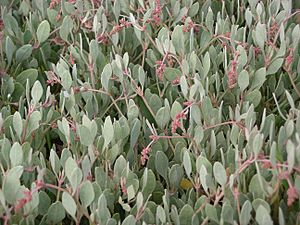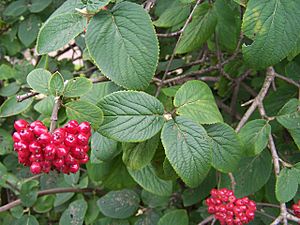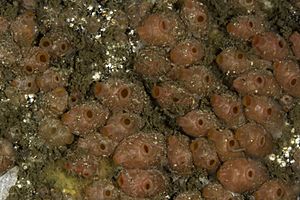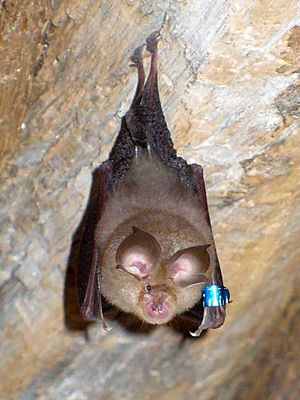Milford Haven Waterway SSSI facts for kids
| Site of Special Scientific Interest | |
| Area of Search | Pembrokeshire |
|---|---|
| Grid reference | to |
| Coordinates | 51°41′25″N 5°00′21″W / 51.69028°N 5.00594°W |
| Interest | Geological and Biological |
| Area | 2,192.1 hectares (5,417 acres) |
| Notification | 2002 |
The Milford Haven Waterway is a very special place in Pembrokeshire, South Wales. It has been protected since 2002 as a Site of Special Scientific Interest (SSSI). This means it's important for its unique rocks, sea life, and many different plants and animals.
Contents
Understanding the Geology of Milford Haven
The Milford Haven Waterway is a great example of a 'ria'. A ria is like a river valley that has been flooded by the sea after the last ice age. It includes many smaller rivers, bays, and inlets.
Cliffs and Rocks
The cliffs in the southern parts are mostly made of Old Red Sandstone. This is a type of rock that formed a very long time ago. In the upper parts of the waterway, the rocks are more mixed and complex.
Some cliffs are very steep. Other areas have a slope with a vertical rock face below. This slope is a leftover from when it was a river valley. It has not been worn away by the sea yet. You can often see stony clays on the middle part of the cliff. These are exposed above the rock faces.
Special Rock Layers
At a place called Little Castle Head, you can see two special layers of rock. These layers are called 'tuff horizons'. They formed from ash that fell during ancient volcanic eruptions. These tuff layers are found within the Sandy Haven Formation.
The two main tuff layers are the Pickard Bay Tuff Bed and the Townsend Tuff Bed. The Townsend Tuff Bed is especially helpful. It acts like a marker that can be found across all the Old Red Sandstone areas in South Wales. At Little Castle Head, these layers are in an area where the rocks are tightly folded. Scientists can see how the thickness of these tuff beds changes across these folds.
Amazing Biology and Wildlife
The Milford Haven Waterway has a main channel with many different types of shores. There are rocky shores, large sandy beaches, and muddy areas called mudflats. These mudflats are found in sheltered spots further up the channel. There are also muddy creeks, known as 'pills', along the inlet.
Life on the Seashore
The foreshore is home to many different marine habitats. These include muddy gravels, sheltered mud, and sandy areas. There are also sheltered rocky areas. These different shore types support a wide variety of creatures.
You can find species-rich rock pools. There are also beds of eelgrass, which are important underwater plants. Underneath rocks and in overhangs, you can find special communities of animals. The strong tidal movements in some places create rich communities. Here you might see the breadcrumb sponge (Halichondria panicea). You can also spot the gooseberry seasquirt (Dendrodoa grossularia) and the star seasquirt (Botryllus schlosseri). Other interesting communities include beds of native oysters (Ostrea edulis). There are also areas with mixed mud and sand that support segmented worms.
Unique Saline Lagoons
The site has three special saline lagoons. These are the Pickleridge lagoon, a weired pool at Westfield Pill, and the old Millpond near Carew Castle. Saline lagoons are very rare habitats in the UK and around the world. They are home to unique species not often found elsewhere.
In these lagoons, you might find the tentacled lagoon worm (Alkmaria romijni). This worm is nationally scarce. You can also find the crustacean Gammarus chevreuxi and the lagoon cockle (Cerastoderma glaucum).
Saltmarshes and Their Plants
The saltmarshes in the Haven are mostly in sheltered areas. You can find them in the upper parts of the main channel. They also grow in the muddy creeks and bays. A variety of saltmarsh communities live here.
The most common plant is common cord-grass (Spartina anglica). This plant is a pioneer species, meaning it's one of the first to grow in new areas. Other common plants include sea purslane (Halimione portulacoides), common saltmarsh grass (Puccinellia maritima), and red fescue (Festuca rubra). These areas can change into upper saltmarsh or brackish communities. Here you might see sea rush (Juncus maritimus) and saltmarsh rush (Juncus gerardii). Some areas even turn into reed-beds dominated by Phragmites australis. Special plants found here include the lax-flowered sea-lavender (Limonium humile) and the one-flowered glasswort (Salicornia pusilla). These are nationally scarce.

Ancient Woodlands and Rare Plants
Old woodlands, mainly with sessile oak (Quercus petraea), grow along parts of the main channel. These woods at Lawrenny date back to at least 1600. Back then, oak woods covered all the shoreline of the Milford Haven valley.
The wild service-tree (Sorbus torminalis) is common on the lower slopes. The ground is rich with plants that show it's an ancient woodland. The woodland also has many interesting lichens. This includes the nationally rare Arthonia astoidestra.
Other Special Plants
The different habitats in the Haven support many flowering plants. The site has some of the largest populations in Pembrokeshire of species that have become rare in the UK. These include dwarf eelgrass (Zostera noltei), marsh pea (Lathyrus palustris), spurge-laurel (Daphne laureola), and wayfaring tree (Viburnum lantana).
Other nationally rare or scarce flowering plants are rock sea-lavender (Limonium procerum spp. cambrense), musk stork's-bill (Erodium moschatum), marsh mallow (Althaea officinalis), and chamomile (Chamaemelum nobile). The coastal slopes also have many mosses and liverworts. The nationally rare moss Tortula cuneifolia has been found here. Other nationally scarce lower plants include the mosses Bryum torquescens and Weissia perssonii. The liverwort Cololejeunea minutissima is also present.

Birds and Otters
The saltmarsh and mudflats in the Haven are very important for birds. Many wildfowl (like ducks and geese) and waders (like curlews) spend the winter here. Their numbers increase during very cold winters. This is because the mild Pembrokeshire climate attracts birds from other frozen estuaries.
Special bird species found here include little grebe (Tachybaptus ruficollis), shelduck (Tadorna tadorna), Eurasian wigeon (Anas penelope), Eurasian teal (Anas crecca), dunlin (Calidris alpina), and Eurasian curlew (Numenius arquata). The Haven is also part of the Cleddau catchment area. This area is one of the most important places in southern Britain for otters.
Important Bat Habitats
Near the Haven, there are important places where bats breed. These sites support internationally important numbers of greater horseshoe bats. They also have nationally important numbers of lesser horseshoe bats.
The woodlands, scrub, and grassland habitats near the main channel are vital feeding grounds for these bats. They also use these areas as flight paths between their roosts. The horseshoe bats and other bat species also sleep in buildings and caves. These roosts are used during the day, for night feeding, or for winter hibernation.
Tiny Creatures: Invertebrates
The saltmarsh is home to several nationally scarce invertebrate species. These include the comb footed spider (Enoplognatha mordex). There are also ground and short-winged mould beetles (Bembidion laterale and Brachygluta simplex). You might find the weevils Polydrusus pulchellus and Notaris bimaculatus. The hoverfly Platycheirus immarginatus and the cranefly Limonia (Dicranomyia) complicata are also present.
Blackthorn (Prunus spinosa) scrub areas support important populations of the brown hairstreak butterfly (Thecla betula). This butterfly has become much rarer in Britain over the last thirty years.
Who Owns and Protects the Waterway?
Parts of the Milford Haven Waterway are owned by Pembrokeshire County Council and the National Trust. Both groups lease some areas to the Wildlife Trust of South and West Wales. The Crown Estate owns most of the foreshore. This is leased to Pembrokeshire County Council and the Pembrokeshire Coast National Park. Sporting rights are leased to local associations.
About two-thirds of the site is within the Pembrokeshire Coast National Park. This area is also part of the Pembrokeshire Marine/Sir Benfo Forol candidate Special Area of Conservation. This protects its estuary, bays, reefs, salt meadows, otters, mudflats, and lagoons.
The otter and the greater and lesser horseshoe bats are listed as important species under a European directive. The tentacled lagoon worm, otter, and both horseshoe bats are also protected under the Wildlife and Countryside Act 1981.
The entire SSSI is part of a Marine Character Area. This area helps the Welsh government understand what makes each seascape special. It is also part of the Pembrokeshire Marine Special Area of Conservation, which was set up in 2004.
How the Site is Managed
The Milford Haven Waterway is divided into 11 smaller areas for easier management. These areas cover the shores and mudflats of most of the ria. They stretch from its mouth at Dale Point and Thorn Island up to the upper parts of the Daugleddau at Haverfordwest and Blackpool Mill.
The different areas include:
- Angle Bay
- Carew and Cresswell Rivers
- Cosheston Pill
- Dale Point to Musselwick Point
- Daugleddau
- Lawrenny Wood
- Littlewick Point to Brunel Quay
- Milford Haven South
- Musselwick Point to Littlewick Point
- Pembroke River
- Sandy Haven



